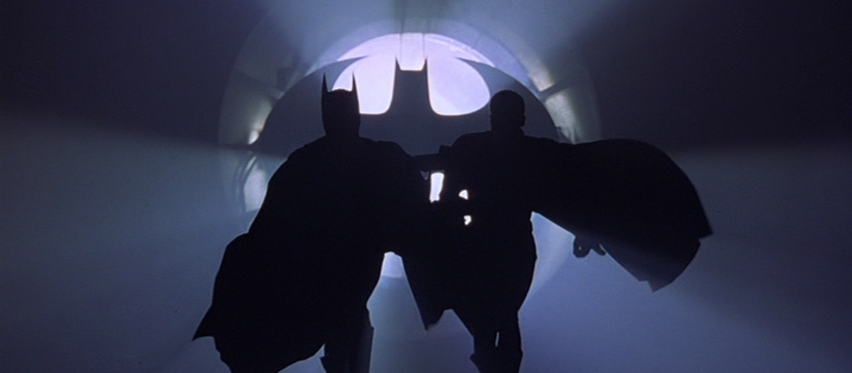
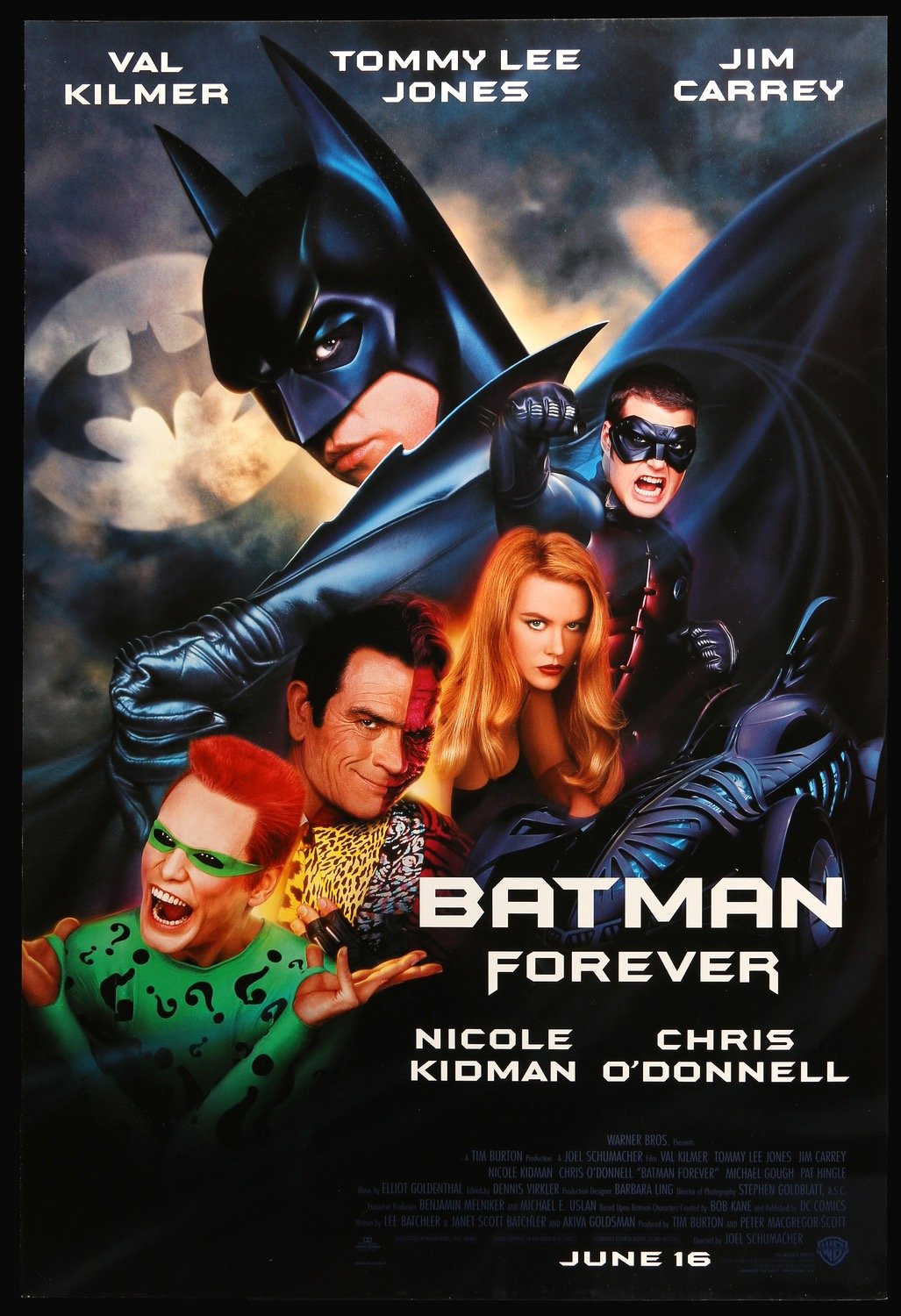
“Riddle me this, riddle me that, who’s afraid of the big, black bat?”
Warner Bros. knew what they were doing when they hired Joel Schumacher to direct Batman Forever. Tim Burton’s Batman Returns had been a decent hit in 1992, but it was not quite the phenomenon that Batman had been a few years prior. And the tone and content of Batman Returns were steeped in Burton’s macabre sensibilities, departing from the nice balance between camp and edginess of the first film (it feels wrong to use the word “original” there). Enter Schumacher, who had made plenty of stylish if somewhat incoherent films in his career, such as The Lost Boys and Flatliners. He seemed like a good fit, capable of making a visually striking Batman film for the masses. As is evidenced by the films that gross the most money each year, audiences are primarily drawn to spectacle—all other cinematic elements are secondary—and that is exactly, and unfortunately exclusively, what Batman Forever delivers.
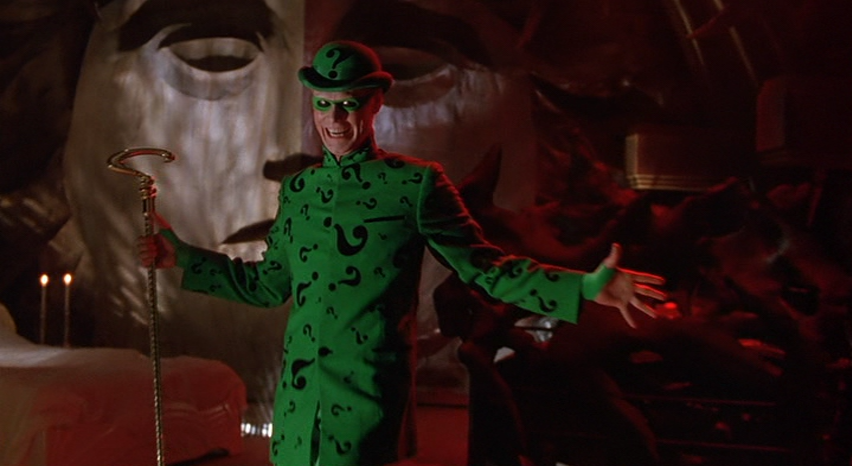
Schumacher had originally been interested in adapting Frank Miller’s Batman: Year One, an origin story, but was forced to make a sequel to Batman Returns (he was able to include some scenes of Bruce Wayne’s childhood, drawing on Miller’s The Dark Knight Returns instead). Like Burton’s two films, Forever is less about Batman than the outrageous villains. Tommy Lee Jones is Two-Face and Jim Carrey is the Riddler, and the two barely even take turns trying to overact each other. Carrey, who had blown up the year prior by starring in three successful films—Ace Ventura: Pet Detective, The Mask, and Dumb & Dumber—portrays Edward Nymga/The Riddler with the same over-the-top shenanigans as those films. That specific mode works for me in limited doses (it works perfectly in Dumb & Dumber) but becomes tiresome very quickly in Batman Forever. Even before he puts on his goofy green costume Carrey is unhinged, barely even acting. His stupid one-liners (“Joy-gasm!”, “Caffeine’ll KILL YA!”) chafe after the first few and aren’t really that funny (and besides humor, I don’t see any other purpose they could have served) and the whole schtick wears thin well before the film ends. Tommy Lee Jones was also not a fan, telling Carrey that he hated him to his face. When Carrey asked him why, Jones said, “I cannot sanction your buffoonery,” which is probably a more considered line than any of those written into the script or ad-libbed by Carrey.
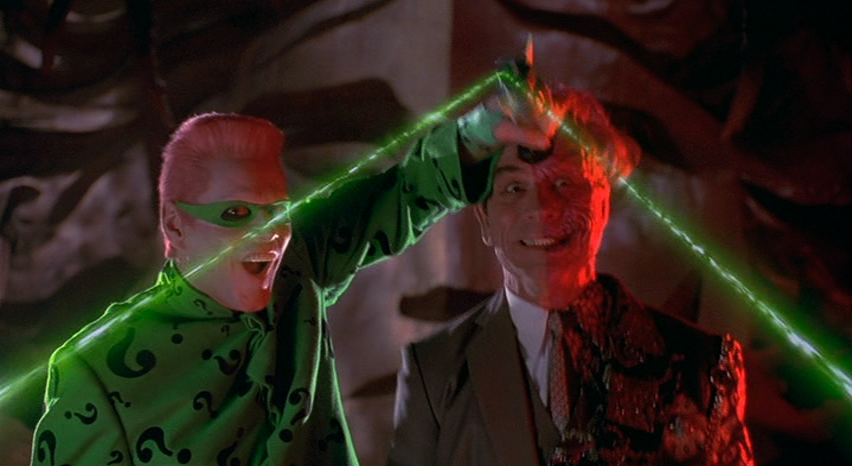
Jones seems to have absorbed Jack Nicholson’s performance as the Joker and plays Two-Face as a knock-off. He cackles and speaks in catch phrases, really hamming up the split personality angle (he has two girlfriends, one for each side of his personality; his rooms are painted and decorated differently on each side, etc.). The performance by Jones is unfortunate because he was really putting in some solid work around this time, in films like Oliver Stone’s JFK, Heaven & Earth, and Natural Born Killers, and Andrew Davis’s The Fugitive (for which he won an Academy Award). Though the Riddler and Two-Face are historically rich characters (both of them made their comic book debuts in the 1940s), in Batman Forever they simply represent chaotic evil for its own sake.
Nicole Kidman portrays Chase Meridian (a name that seems like it belongs to a bank that pesters you with credit card offers rather than to Batman’s love interest), an apparently brilliant psychologist who seems to do nothing but sigh and try to seduce Batman with some kind of voodoo doll. She can’t decide if she has the hots for Batman or Bruce Wayne despite Wayne repeatedly implying that he is Batman. Kilmer is ridiculously stone-faced throughout the film, and appears to simply be here for the large paycheck. Kilmer is a pretty good actor, and had recently done very good work in Tombstone (1993) and True Romance (1993) and was also about to star in Heat (1995); he’s no slouch, but his acting here leaves a lot to be desired.
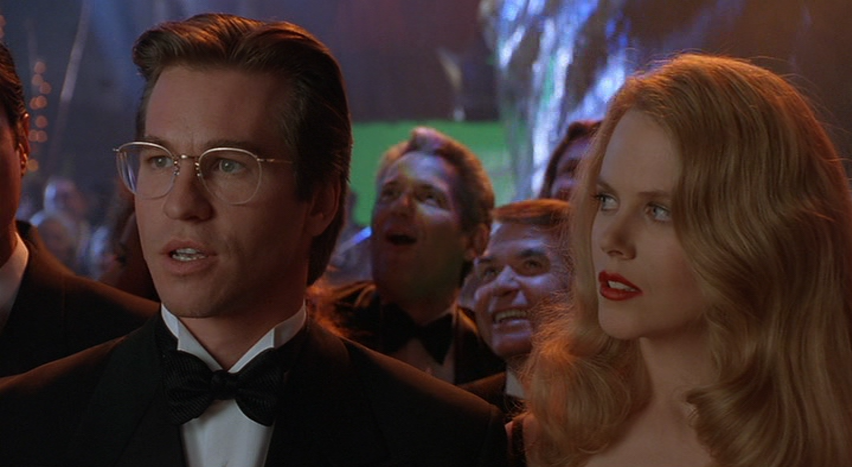
Though there are references to the previous two films (and Michael Gough and Pat Hingle return as Alfred and Commissioner Gordon, respectively), the films are mostly a complete departure from Burton’s movies.1 Chris O’Donnell rounds out the main cast as Dick Grayson (AKA Robin), while a pre-Scream Drew Barrymore makes the most of a minor role as Two-Faces assistant Sugar. The best scene in the film is Robin’s origin story. Bruce Wayne takes Dr. Meridian on a date to the circus (you would think he’d be scared of clowns by now after the first two films) where the Flying Graysons are performing an acrobatic routine before Two-Face takes center stage and demands to know the identity of Batman, or else. It is visually compelling, well-shot, and emotionally resonant. But then when we actually meet Dick Grayson, he turns out to be an incredibly shallow character, an angsty rebel who deals with his trauma about as believably as a cheap soap opera would handle it.
I could continue with the negatives, but I prefer to let this dead horse lie. Suffice to say that the film never really amounts to anything, and its writing and acting result in a nonsensical final product (note that until now I have courteously not mentioned that the main plot device is that the Riddler and Two-Face team up to mass manufacture Edward Nygma’s brainwave-capturing device in order to discover Batman’s identity).2 Despite its shortcomings, the film is memorable; one of those that sticks in your mind due to its excess and outrageous imagery. With its darker tone, Batman Returns had alienated part of its audience, namely the children for whom Batman was traditionally marketed. In returning to a campier aesthetic, Batman Forever recaptures some of that juvenile appeal that could leave a youngster with a lasting memory.
1. Like many high-profile films, the casting history of Batman Forever is complex and features a large number of notable names. Michael Keaton was signed on for the third film, but left due to creative differences, turning down a $15 million paycheck. Michelle Pfeiffer’s Catwoman was initially penciled into the third film but was cut out in favor of new villains. Billy Dee Williams, who had portrayed Harvey Dent in Batman specifically so that he could be Two-Face, was jettisoned in favor of Jones. With all the changes, it’s almost impossible to think of the three films (actually four, including Schumacher’s second outing on Batman & Robin) as a single series.
2. The original cut of the film was reportedly forty minutes longer than what was released. So maybe there is a hidden gem of a cut lurking in a vault somewhere. But probably not. That version is probably equally as silly.
Sources:
Shadows of the Bat: The Cinematic Saga of the Dark Knight (DVD). Warner Home Video. 2005.
Nordine, Michael. “Tommy Lee Jones Told Jim Carrey ‘I Cannot Sanction Your Buffoonery’ While They Were Making ‘Batman Forever’”. IndieWire. 5 October 2017.